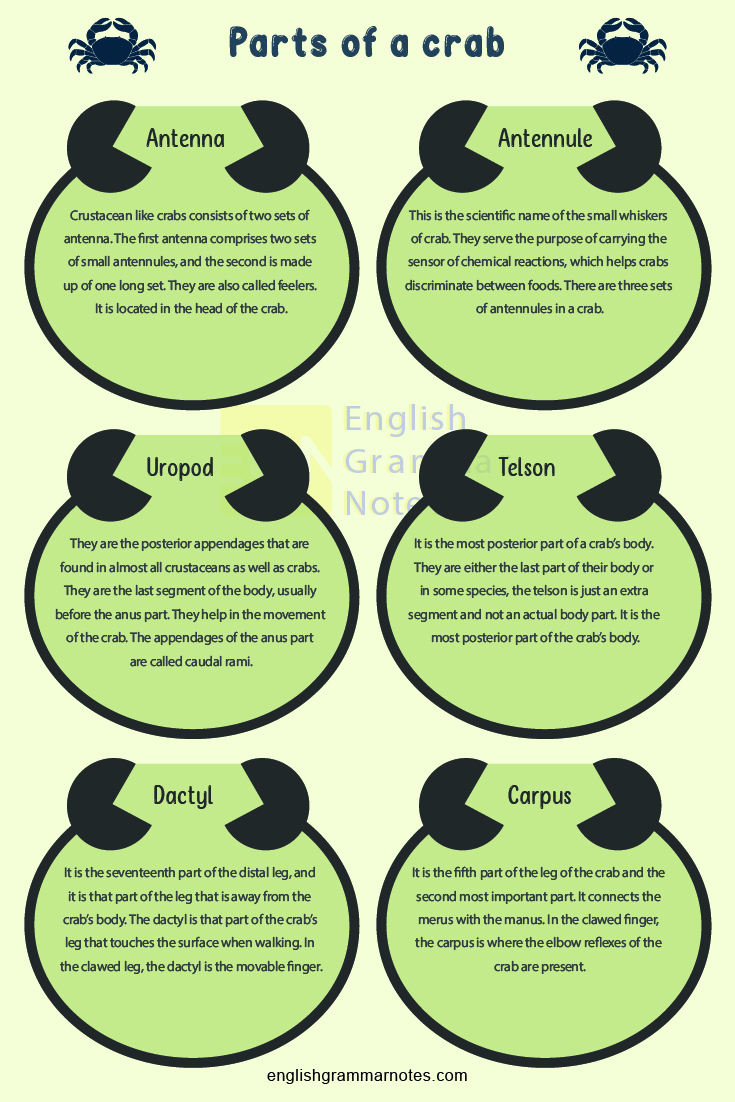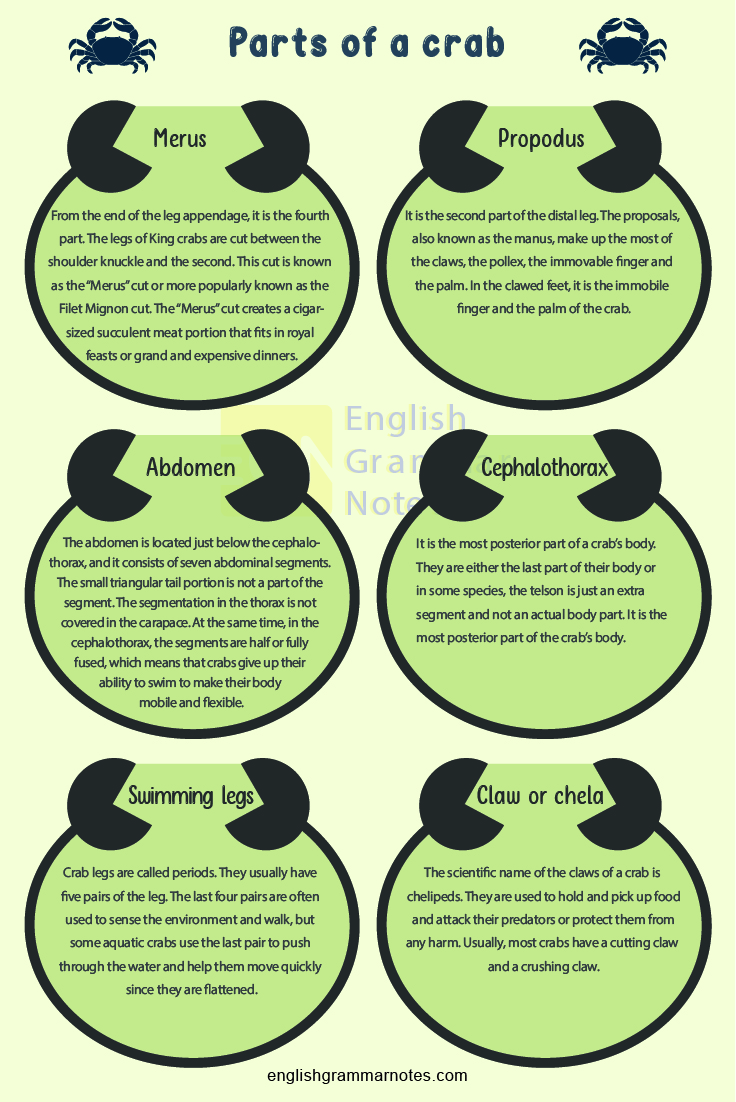Parts of a Crab: Crabs have a segmented body, and their body can divide into two portions: the cephalothorax (head and the chest) and the abdomen (belly). Crabs have ten legs. They generally belong to the group of crustaceans or decapods. We have made a list of parts of crab for you.
You can find crabs in almost all the world’s water bodies, including oceans, freshwater streams, and also on the land. The body of the crab is covered with an exoskeleton, and they sport a pair of pincers. Although several other crustaceans, such as king crabs and porcelain crabs, have some similar features to that of a crab, they are not crabs in their truest sense.
Study the most important English Vocabulary Words identified by our experts and learn the right vocabulary to use in your day to day conversations
Crabs usually have a flat body, and their head and thorax get connected below the carapace. In addition, crabs usually don’t sport a tail. Crab anatomy will help the readers increase their knowledge of English vocabulary and help them know about the uses of different parts of crab and the best parts of crab to eat.
List of Parts of a crab
Name of parts of a crab
- Claw or chela
- Antenna
- Antennule
- Uropod
- Telson
- Eyes
- Dactyl
- Carpus
- Cephalothorax
- Abdomen
- Swimming legs
- Walking legs
- Merus
- Propodus
Description of parts of a crab on the list
Claw or chela
The scientific name of the claws of a crab is chelipeds. They are used to hold and pick up food and attack their predators or protect them from any harm. Usually, most crabs have a cutting claw and a crushing claw.
Antenna
Crustacean like crabs consists of two sets of antenna. The first antenna comprises two sets of small antennules, and the second is made up of one long set. They are also called feelers. It is located in the head of the crab.
Antennule
This is the scientific name of the small whiskers of crab. They serve the purpose of carrying the sensor of chemical reactions, which helps crabs discriminate between foods. There are three sets of antennules in a crab.
Uropod
They are the posterior appendages that are found in almost all crustaceans as well as crabs. They are the last segment of the body, usually before the anus part. They help in the movement of the crab. The appendages of the anus part are called caudal rami.
Telson
It is the most posterior part of a crab’s body. They are either the last part of their body or in some species, the telson is just an extra segment and not an actual body part.
It is the most posterior part of the crab’s body.
Eyes
They are located in independently movable and adjustable eye stalks. Crabs sport compound eyes which means they have a panoramic vision. You can fold their eyes in the stalks, which also helps in protecting them.
Since crabs have compound eyes, they can’t focus well, but their eyes are sensitive enough to detect UV rays and notice the slightest movements. In addition, the eyestalks give a hormone that helps the crabs in their moulting process. Although they can regenerate their lost claws or legs through the process, they can’t regenerate their lost eye.
Dactyl
It is the seventeenth part of the distal leg, and it is that part of the leg that is away from the crab’s body. The dactyl is that part of the crab’s leg that touches the surface when walking. In the clawed leg, the dactyl is the movable finger.
Carpus
It is the fifth part of the leg of the crab and the second most important part. It connects the merus with the manus. In the clawed finger, the carpus is where the elbow reflexes of the crab are present.

Cephalothorax
The term cephalothorax consists of cephalic and thoracic, which means the head and chest, respectively.
Therefore, the cephalothorax consists of the head and chest regions of the crab. Carapace, the hard and lateral covering of the head and the chest protects all the vital organs of the crabs such as the head, stomach, bladder, testicular and others from above but not ventrally.
Abdomen
The abdomen is located just below the cephalothorax, and it consists of seven abdominal segments. The small triangular tail portion is not a part of the segment. The segmentation in the thorax is not covered in the carapace. At the same time, in the cephalothorax, the segments are half or fully fused, which means that crabs give up their ability to swim to make their body mobile and flexible.
Swimming legs
Crab legs are called periods. They usually have five pairs of the leg. The last four pairs are often used to sense the environment and walk, but some aquatic crabs use the last pair to push through the water and help them move quickly since they are flattened.

Walking legs
Crab legs are called periods. They usually have five pairs of the leg. The last four pairs of legs are often used to sense the environment and walk; hence they are called the walking legs.
Crabs usually walk sideways since their legs are joined at the side of the body, and the joints are pointed upwards. Many other crustaceans or false crabs, such as hermit crabs and porcelain crabs, resemble a crab very well but have only three pairs of legs.
Merus
From the end of the leg appendage, it is the fourth part. The legs of King crabs are cut between the shoulder knuckle and the second. This cut is known as the “Merus” cut or more popularly known as the Filet Mignon cut. The “Merus” cut creates a cigar-sized succulent meat portion that fits in royal feasts or grand and expensive dinners.
Propodus
It is the second part of the distal leg. The proposals, also known as the manus, make up the most of the claws, the pollex, the immovable finger and the palm. In the clawed feet, it is the immobile finger and the palm of the crab.